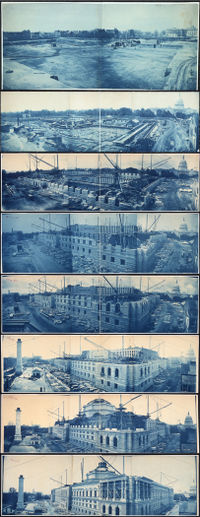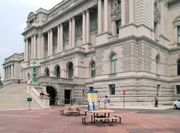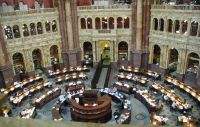Library of Congress
2007 Schools Wikipedia Selection. Related subjects: Politics and government
The Library of Congress is the de facto national library of the United States and the research arm of the United States Congress. It is one of the largest and most important libraries in the world. Its collections include more than 29 million catalogued books and other print materials in 470 languages; more than 58 million manuscripts; the largest rare book collection in North America, including a Gutenberg Bible; over 1 million US Government publications; 1 million issues of world newspapers spanning the past three centuries; 33,000 bound newspaper volumes; 500,000 microfilm reels; over 6,000 comic book titles; the world's largest collection of legal materials; films; 4.8 million maps; sheet music; and 2.7 million sound recordings. The head of the Library is the Librarian of Congress.
History
The Library of Congress was established on April 24, 1800, when President John Adams signed an act of Congress providing for the transfer of the seat of government from Philadelphia to the new capital city of Washington. The legislation appropriated $5,000 "for the purchase of such books as may be necessary for the use of Congress ..., and for fitting up a suitable apartment for containing them...." The original library was housed in the new Capitol until August 1814, when invading British troops set fire to the Capitol building, destroying the contents of the small (3,000 volumes) library.
Within a month, former President Thomas Jefferson offered his personal library as a replacement. Jefferson had spent 50 years accumulating books, "putting by everything which related to America, and indeed whatever was rare and valuable in every science"; his library was considered to be one of the finest in the United States. Jefferson, who was heavily indebted, sought to use the proceeds of the sale of his books to satisfy his creditors. He anticipated controversy over the nature of his collection, which included books in foreign languages and volumes of philosophy, science, literature, and other topics not normally viewed as part of a legislative library. To satisfy any objections as to the suitability of his collection for Congress' use, he wrote, "I do not know that it contains any branch of science which Congress would wish to exclude from their collection; there is, in fact, no subject to which a Member of Congress may not have occasion to refer."
In January 1815, Congress accepted Jefferson's offer, appropriating $23,950 for his 6,487 books, and the foundation was laid for a great national library. The Jeffersonian concept of universality, the belief that all subjects are important to the library of the American legislature, is the philosophy and rationale behind the comprehensive collecting policies of today's Library of Congress.
On December 24, 1851, a fire destroyed 35,000 books, an original portrait of Christopher Columbus, portraits of the first five US Presidents by Gilbert Stuart, and statues of George Washington, Thomas Jefferson and Marquis de Lafayette.
The Library is now spread over three buildings in Washington, D.C.:
- The Thomas Jefferson Building (between Independence Avenue and East Capitol Street on First Street SE), opened in 1897, and long the main building of the Library;
- The John Adams Building (between Independence Avenue and East Capitol Street on 2nd Street SE), opened as an annex in 1938; and
- The James Madison Memorial Building (between First and Second Streets on Independence Avenue SE), opened in 1981 as the new headquarters of the Library.
(Note: Between April 13, 1976 and June 13, 1980, the John Adams Building was known as the Thomas Jefferson Building.)
In late-November 2005, the Library announced intentions to launch the World Digital Library, digitally preserving books and other objects from all world cultures.
Holdings
The Library developed a system of book classification called Library of Congress Classification (LC) which is used by most US research and university libraries, although most public libraries continue to use the Dewey decimal system.
The Library serves as a legal repository for copyright protection and copyright registration, and as the base for the United States Copyright Office. Regardless of whether they are seeking copyright, all publishers are required to submit two copies of their copyrightable works to the Library - this requirement is known as mandatory deposit. Nearly 22,000 new items published in the U.S. arrive every business day at the Library. Contrary to popular belief, however, the Library does not retain all of these works in its permanent collection, although it does add an average of 10,000 items per day. Rejected items are used in trades with other libraries around the world, distributed to federal agencies, or donated to schools, communities, and other organizations within the United States. As is true of many similar libraries, the Library of Congress retains copies of every publication in the English language which is deemed significant.
The Guinness Book of World Records currently lists the Library of Congress as the "World's Largest Library". This apparently is based on the shelf space the collection occupies; the Library of Congress states that its collection fills about 530 miles (850 km), while the British Library, reports about 388 miles (625 km) of shelves. The Library of Congress holds about 130 million items with 29 million books against approximately 150 million items with 25 million books for the British Library.
It is estimated that the print holdings of the Library of Congress would, if digitized and stored as plain text, constitute 17 to 20 terabytes of information. This leads many people to conclude that 20 terabytes is equivalent to the entire holdings of the Library, but this is misleading because many items have not been digitized, and not all of them consist of plain text. (Occasionally, this figure has been referred to as a data transfer rate, LoC/s — Libraries of Congress per second – defined as 20 terabytes of data transferred per second). The Library currently has no plans for systematic digitization of any significant portion of its books.
The Library makes millions of digital objects, comprising tens of terabytes, available at its American Memory site. American Memory is a source for public domain image resources, as well as audio, video, and archived Web content. Nearly all of the lists of holdings, the catalogs of the library, can be consulted directly on its web site. Librarians all over the world consult these catalogs, through the Web or through other media better suited to their needs, when they need to catalog for their collection a book published in the United States. They use the Library of Congress Control Number to make sure of the exact identity of the book.
The Library of Congress also provides an on-line archive of the proceedings of the U.S. Congress at THOMAS, including bill text, Congressional Record text, bill summary and status, the Congressional Record Index, and the United States Constitution.
The Library also administers the National Library Service for the Blind and Physically Handicapped, a talking and Braille library program provided to more than 766,000 Americans.
Using the Library
The library is open to the general public for academic research, and runs tours for visitors. Only those who are issued a "Reader Identification Card" may enter the reading rooms and access the collection. The Reader Identification Card is available in the Madison building to persons who are over 18 years of age upon presentation of a government issued picture identification (e.g., driver's license, state ID card or passport). However, only members of Congress, Supreme Court Justices, their staff, Library of Congress staff and certain other government officials can actually check out books.
Libraries in the United States may request books and other items through interlibrary loan from the Library of Congress if these items are not readily available elsewhere. Since 1902, the Library of Congress has served as a "library of last resort."
Annual events
Annual events include:
- The National Book Festival
- Founder's Day Celebration
- Archives Fair
- Judith P. Austin Memorial Lecture
- Davidson Fellows Reception




